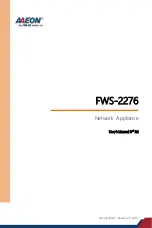
21-10
Cisco Catalyst Blade Switch 3120 for HP Software Configuration Guide
OL-12247-01
Chapter 21 Configuring DHCP Features and IP Source Guard
Configuring DHCP Features
•
Before configuring the DHCP relay agent on your switch, make sure to configure the device that is
acting as the DHCP server. For example, you must specify the IP addresses that the DHCP server
can assign or exclude, configure DHCP options for devices, or set up the DHCP database agent.
•
If the DHCP relay agent is enabled but DHCP snooping is disabled, the DHCP option-82 data
insertion feature is not supported.
•
If a switch port is connected to a DHCP server, configure a port as trusted by entering the ip dhcp
snooping trust interface configuration command.
•
If a switch port is connected to a DHCP client, configure a port as untrusted by entering the no ip
dhcp snooping trust interface configuration command.
•
Follow these guidelines when configuring the DHCP snooping binding database:
–
Because both NVRAM and the flash memory have limited storage capacity, we recommend that
you store the binding file on a TFTP server.
–
For network-based URLs (such as TFTP and FTP), you must create an empty file at the
configured URL before the switch can write bindings to the binding file at that URL. See the
documentation for your TFTP server to determine whether you must first create an empty file
on the server; some TFTP servers cannot be configured this way.
–
To ensure that the lease time in the database is accurate, we recommend that you enable and
configure NTP. For more information, see the
“Configuring NTP” section on page 6-3
.
–
If NTP is configured, the switch writes binding changes to the binding file only when the switch
system clock is synchronized with NTP.
•
Do not enter the ip dhcp snooping information option allow-untrusted command on an
aggregation switch to which an untrusted device is connected. If you enter this command, an
untrusted device might spoof the option-82 information.
•
Starting with Cisco IOS Release 12.2(37)SE, you can display DHCP snooping statistics by entering
the show ip dhcp snooping statistics user EXEC command, and you can clear the snooping
statistics counters by entering the clear ip dhcp snooping statistics privileged EXEC command.
Configuring the DHCP Server
The switch can act as a DHCP server. By default, the Cisco IOS DHCP server and relay agent features
are enabled on your switch but are not configured. These features are not operational.
For procedures to configure the switch as a DHCP server, see the “Configuring DHCP” section of the
“IP addressing and Services” section of the Cisco IOS IP Configuration Guide, Release 12.2.
DHCP Server and Switch Stacks
The DHCP binding database is managed on the stack master. When a new stack master is assigned, the
new master downloads the saved binding database from the TFTP server. If the stack master fails, all
unsaved bindings are lost. The IP addresses associated with the lost bindings are released. You should
configure an automatic backup by using the ip dhcp database url [timeout seconds | write-delay
seconds] global configuration command.
When a stack merge occurs, the stack master that becomes a stack member loses all of the DHCP lease
bindings. With a stack partition, the new master in the partition acts as a new DHCP server without any
of the existing DHCP lease bindings.
For more information about the switch stack, see
Chapter 5, “Managing Switch Stacks.”





































